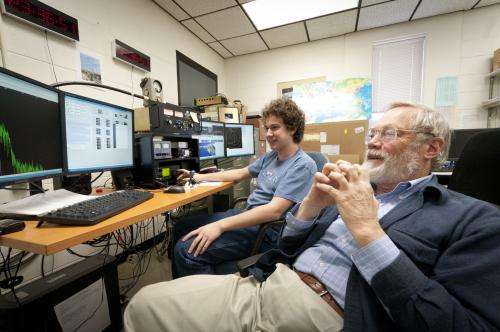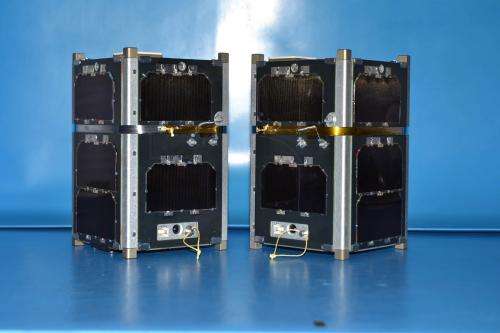Two MSU-built satellites set to launch early Dec. 6

Two more satellites built by Montana State University students are scheduled to be lofted into space this week under NASA's Educational Launch of Nanosatellites (ELaNa-2) program.
If the ground temperature is at least 40 degrees and everything else goes as planned, the identical CubeSats will be launched at 12:13 a.m. Mountain time Friday (Dec. 6) from the Vandenberg Air Force Base in California, said David Klumpar, director of MSU's Space Science and Engineering Laboratory (SSEL).
The satellites will be released around 3 a.m. Mountain time from the Centaur upper stage of the Atlas-5 rocket that will carry them into space. The satellites, known together as FIREBIRD, will pass over Bozeman at 4:27 a.m., giving MSU students about seven minutes to communicate with them before they continue their orbit around the Earth.
Approximately 30 MSU students, in conjunction with partners at the University of New Hampshire, built the satellites over the past four years, Klumpar said. Most of MSU's students were undergraduates and majoring in engineering or physics.
"It's such a tremendous opportunity for our undergraduate students to start practicing their careers well before they take their first job," Klumpar said. "It lets the students understand what their career will be like while they can still change their mind. If they do decide to stay with the aerospace business, they have a head start on their career, which puts them well in front of 98 percent of their peers."

Among the students who will gather in Cobleigh Hall late Thursday night and early Friday to watch the launch and monitor the satellites will be Matt Handley of St. Albans, W.Va., a junior in computer engineering. Also there will be Brian Larsen, one of the science collaborators in the FIREBIRD mission and a former MSU doctoral student who now works at Los Alamos National Laboratory. Klumpar and his counterpart at the University of New Hampshire will watch the launch from the Vandenberg Air Force Base.
Handley, who has a final exam later Friday, designed software for FIREBIRD and watched when MSU's first student-built satellite launched on Oct. 28, 2011. That CubeSat, called the Hiscock Radiation Belt Explorer (HRBE), has now orbited the Earth more than 10,750 times and is still sending back information to Handley and other students in MSU's Space Operations Center in Cobleigh Hall.
It was interesting to become involved with HRBE toward the end of that project and then become involved with FIREBIRD earlier in the process, Handley said. Handley became associated with the SSEL the first week of his freshman year. After he earns his bachelor's degree, he hopes to attend graduate school at MSU and then work in the aerospace industry.
"I have had a good time here. I have learned a lot," Handley said.
Larry Springer, SSEL program manager, said the MSU satellites are among 12 CubeSats that will hitch a ride as secondary payloads on the upcoming launch. They are also the first two nanosatellites scheduled to be released from the rocket. The FIREBIRD satellites will separate from each other and eventually fly 124 to 186 miles apart in an orbit 280 to 541 miles above the Earth. They may stay in space for several years, but their most important job will be done over the next three months when they gather more information about the loss of electrons from the Van Allen Radiation Belts. Radiation in space affects Earth in a variety of ways, including interference with communication systems and power grids.
Klumpar said electrons become trapped in the Earth's magnetic field, but the trap is leaky, causing electrons to be lost into the upper atmosphere from the Van Allen Radiation Belts. To better understand the process and impacts, MSU and the University of New Hampshire designed two satellites that will gather information in tandem. The satellites are slightly taller than HRBE, which is a cube about four inches on each side. The FIREBIRD satellites conform to a nanosatellite size standard, known as the CubeSat standard, which allows them to ride together in a container called a PPOD. FIREBIRD refers to Focused Investigations of Relativistic Electron Burst, Intensity, Range and Dynamics.
Provided by Montana State University



















